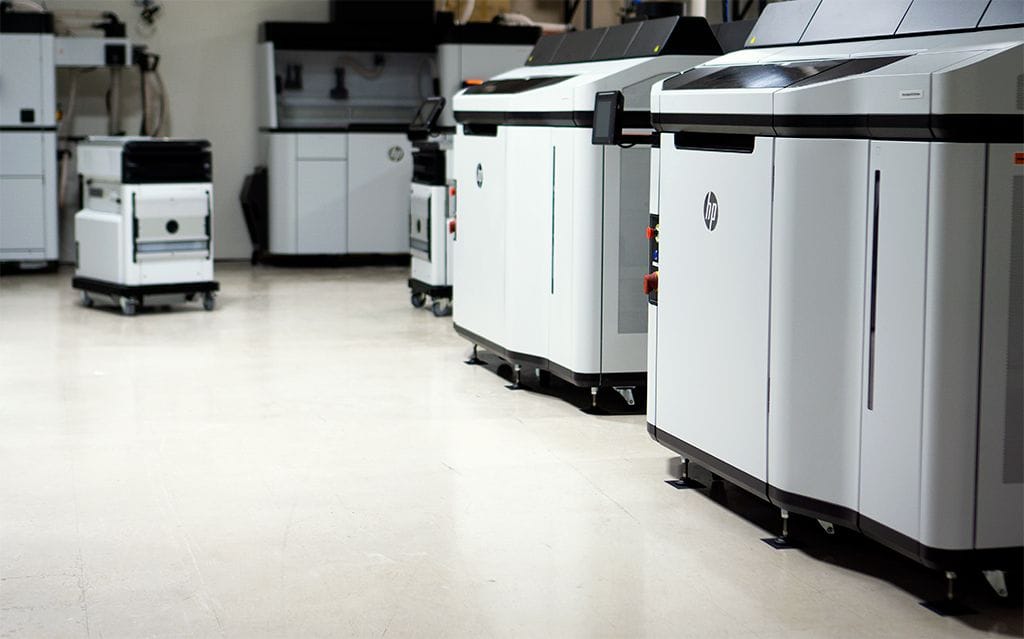![HP 5210 3D printers at FORECAST 3D [Source: FORECAST 3D]](https://fabbaloo.com/wp-content/uploads/2020/05/image-asset_img_5eb09185878e6.jpg)
FORECAST 3D announced today the acquisition of two additional HP industrial 3D printers.
The company, situated between Los Angeles and San Diego in Carlsbad, first launched their 3D print services in 1994 with the purchase of a single SLA unit. Since then they’ve expanded quite dramatically and now offer FDM, DMLS, SLA, PolyJet, CNC, Injection Molding and MJF making services.
They have (literally) tons of machines in these categories, but it seems they have the most invested in HP’s MJF technology. They previously had an astounding 24 HP MJF units, and with the addition of two HP Jet Fusion 5210 Pro industrial 3D printers, they’ll be up to 26 units. They must have one of the largest installations of HP 3D printing technology on the planet at this point.
BASF’s ULTRASINT TPU
Previously the company offered HP 3D printing services in three materials: PA12, PA12 w glass beads, and PA11. With the new equipment they will be offering an additional material, HP’s TPU material, which is actually BASF’s ULTRASINT product. This is a certified elastomer suitable for many applications.
Their now-massive fleet of HP machines will allow them to produce rather large quantities of parts for their clients using MJF in relatively short order. They say “low-volume manufacturing” is a 3D printing capability, but here FORECAST 3D may have moved the line a bit.
I’m not surprised that this has occurred, not the least of which is that we continue to get good reports on HP’s part quality. But there’s another reason for this development, and it has to do with HP’s MJF 3D printing process.
HP’s MJF 3D Printing Process
The MJF concept is based somewhat on HP’s 2D printing technology in which tiny droplets are swiftly dropped onto moving sheets to form 2D output. Similar droplet tech in the MJF process deposits liquid droplets onto a flat bed of material powder in the build chamber. This is done repeatedly, layer by layer, until the object is completed.
While the first build chamber is removed and is cooling, a second build chamber can be placed into the MJF printer for a second print job to commence. In this way the HP technology provides for greater throughput through overlapping operational steps.
MJF Cooling Challenges
Once the first build chamber is finished heating, it must then cool down. This is the challenge of the MJF process: the cooling can take many hours because it’s a large block with not a lot of surface area, although HP did release a device with a smaller build chamber that allows for a somewhat faster cooling period. There’s also been some improvements to the cooling process with more recent post-processing stations from HP.
This cooling delay means that it is generally not a great idea to print a single part on an MJF machine due to the cycle time. No, instead these machines are best used for volume production, where you can get a ton of parts completed in each print job. HP’s technology prioritizes throughput over raw speed.
For some applications, like iterative prototyping of single units, that’s not the greatest use of MJF. On the other hand, if you need 100, 1000 or even 10,000 units you can produce them in good time by leveraging the relatively large build chamber volumes on the HP equipment.
Thus you tend to see the HP technology more often in the hands of 3D print service bureaus than used intermittently in the corner of the development lab in an office, like many other 3D printers might be. Instead, these things are ideal for service bureaus where incoming customer requests can be batched up and printed all at once, truly leveraging MJF’s throughput ability.
“Big” Low-Volume Manufacturing Capacity
And that seems to be exactly what FORECAST 3D is doing here, and even more so. Not only do they use the high-throughput MJF process, they have no fewer than twenty-six units to do it on.
Let’s do some arithmetic. Say you have ten HP 4200 MJF 3D printers. These machines have a generous build volume of 380 x 284 x 380 mm, meaning that if you had a part of size 50 x 50 x 50 mm, you could fit an astounding 328 in each print job. If you have ten machines producing them, then you can build 3,280 per print job, which likely takes less than a day. That’s a pretty high volume.
There are now several different types of 3D print service capabilities, and one of them is high-volume printing. If you happen to require that, then you might want to check out FORECAST 3D.
Via FORECAST 3D











MakerOS has a brilliant hidden feature in their online service: a sophisticated 3D print pricing calculator that allows operators to determine exactly how to price prints.